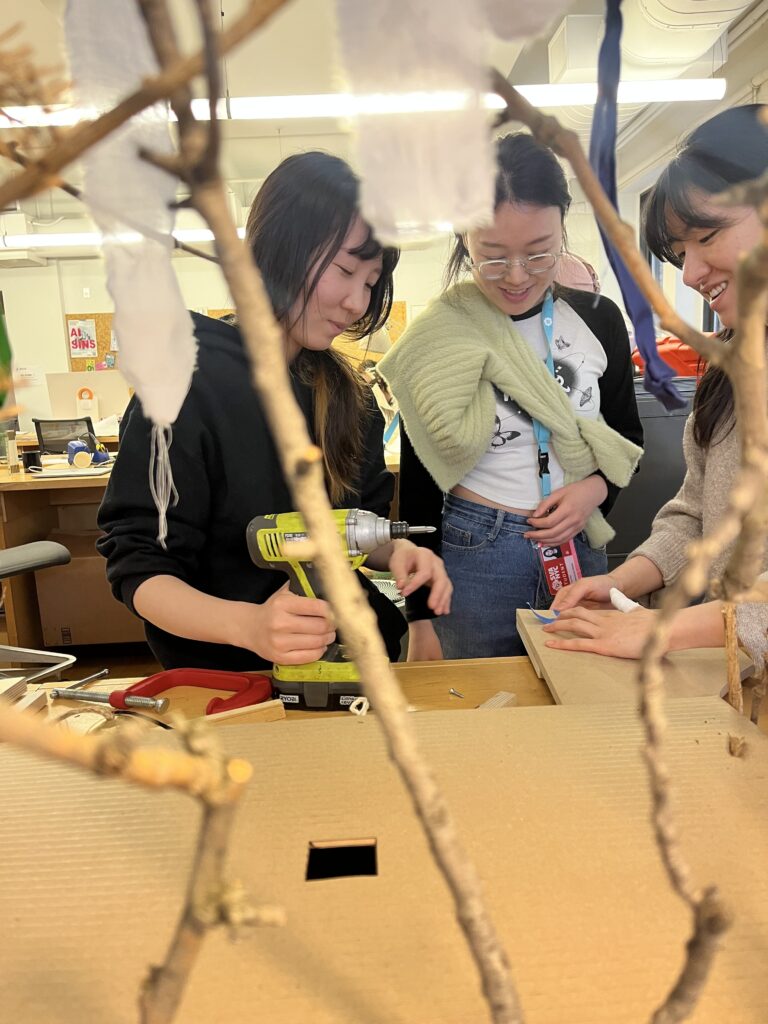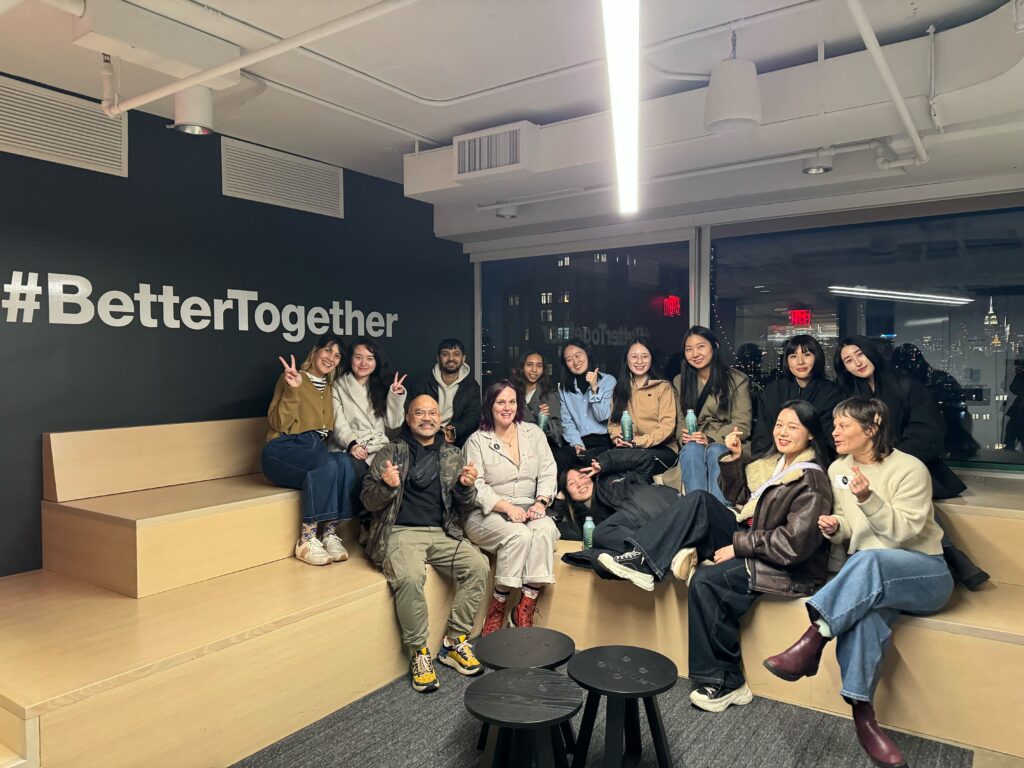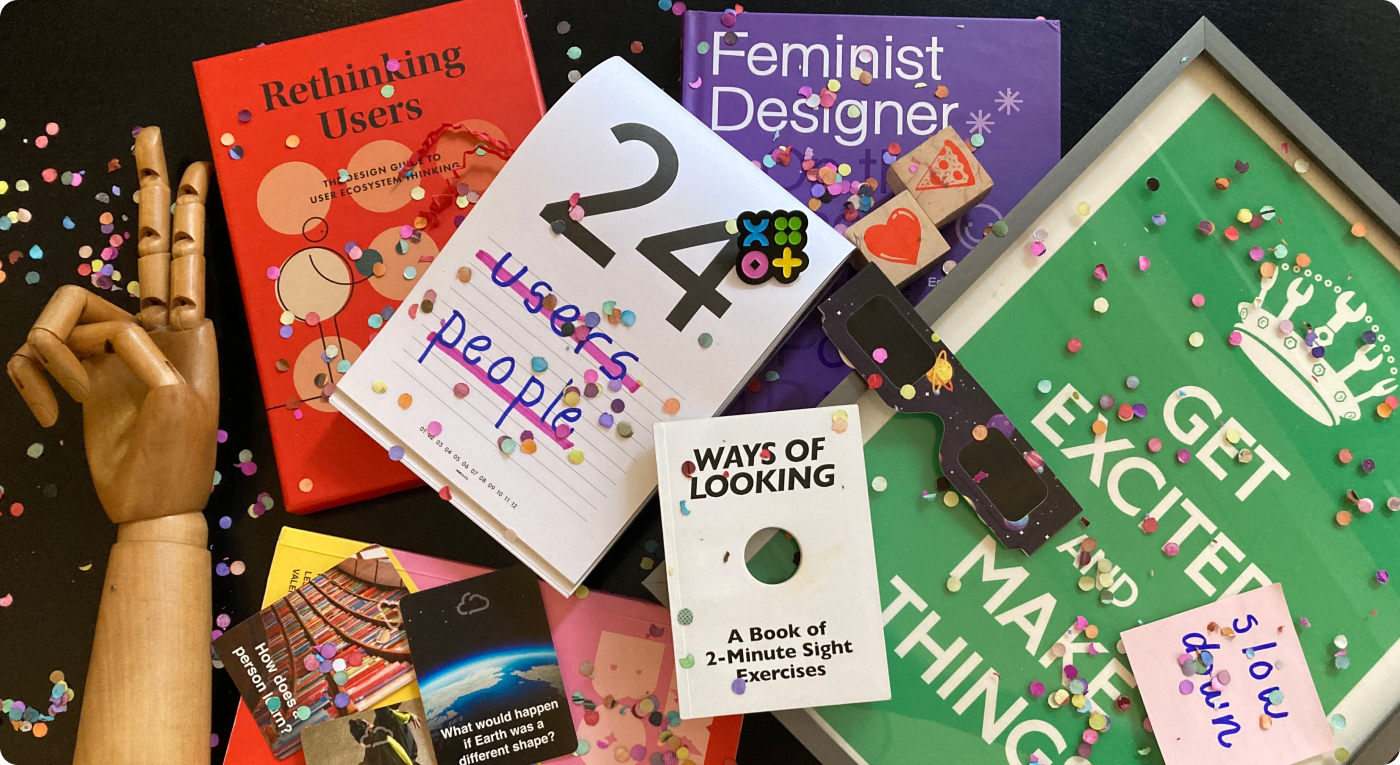Lead banner: A snapshot of a tabletop at MFA Interaction Design filled with inclusive design tools and inspiration. Photo by Adriana Valdez Young
“The second years are starting to redesign our bathrooms today!” Adriana Valdez Young welcomed me into a sunbathed design studio at the School of Visual Arts (SVA) in Chelsea. With a two-toned bob, scuffed white sneakers, and a sparkle in her eye, her enthusiasm for refreshing the porcelain palace was infectious. Redesigning bathrooms? In a graduate interaction design program?
“I’ve always been working towards a world in which design for people, design for good, inclusive design, is just good design,” said Young, design researcher and acting chair of the MFA Interaction Design program at SVA. For decades thought leaders have been working to pinpoint the future of good design–and educators have been simply trying to keep up. Now they’re shaping the future themselves. This year, Young collaborated with Pinar Guvenc, partner at the award-winning global design firm SOUR, to construct the first year-long, graduate-level Inclusive Design course in the United States.

Designed to train the next generation of strategic, collaborative, thoughtful, and yes, inclusive designers, Inclusive Design I & II is SVA’s response to corporate reconstruction across industries. Since November 2023, interaction has seen mass layoffs from design leaders like IDEO and technology mega-companies including Google and Microsoft, citing “weak consumer demand.”
There is demand, just not for their products. People with disabilities hold about $490b in purchasing power in the United States, while 68% of Gen Z prioritizes sustainable shopping. With these two groups holding consumer power, organizations have come to understand that corporate sustainability means social responsibility. Solutions are scarce, as design and tech hemorrhage capital in search of a new ‘new normal.’
With an undefined future, the leadership at MFA Interaction Design chose to focus on the only two constants in design — people and their problems. “Every designer is a social impact designer,” said Young. “Whether they like it or not, they’re having an impact on society and people.”
Instilling inclusion, co-creation, and engagement into design processes may provide the necessary salve to these wounds, setting a strong foundation for our future. It’s the curb cut effect when a design created for a few changes the lives of many. Think of the touch screen on your trusty smartphone, rubber grips on vegetable peelers, or closed captioning; all universal products initially designed with the disabled community in mind. “If you’re not co-creating with people, what you’re putting out there is not going to stick or it’s not going to last, and therefore it’s not going to sustain,” said Guvenc.
Initially designed in two parts stretching over the second year of the MFA program, the course starts slow—painfully slow. Much of Inclusive Design I is spent slowing down, observing, deepening vocabulary, and unlearning traditional design processes. The MFA program defines inclusive design as designing with, not for, communities we aim to serve, recognizing that lived experiences are equally as important as professional expertise. The first few classes are simple yet complex, differentiating inclusive from accessible, universal, or equitable design and exploring what it means to actively invite participants into the process as co-designers.
From early January to May 2024, the second year students in Inclusive Design II were given the mammoth task of redesigning their studio bathrooms. Though interaction design is often seen as a technological field, SVA broadens this definition to include the vast system of networks, services, narratives, products, and experiences shaping our daily lives. “Inclusion, where it differs from accessibility, is not necessarily concerned about the baseline axis,” said Guvenc. “It is concerned about the entire journey and the experience.” Because of this, the faculty chose to focus on a physical, universal human experience to frame the class project in the course’s pilot year.
This initial class has proven to be a fruitful struggle. Designing for inclusion is a complex, intentional process, filled with co-creation, value-setting, shifting mindsets, community research, and detailed prototyping. As students began conducting anonymous surveys, Guvenc and Young found the emerging designers stuck in habitual thinking and linear processes; many of the students’ first drafts included problematic language and ableist assumptions. Several final prototypes raised an eyebrow, including one with signage depicting a male and female icon perpetuating the gender binary.
“These deeply ingrained mindsets and habits take time to break,” said Young. “For me, it’s about being patient; knowing that we have planted the seed and that seed might sprout later in their design careers.”
The students’ thinking evolved greatly, even if there wasn’t a sharp pivot in their work this year. “Inclusive design is a mindset I can keep with myself, in all types of design,” said Fan Fang, product designer and soon-to-be MFA Interaction Design graduate. “[The course] helped me learn how to decentralize my role as a designer.” Fan Fang’s thesis project focuses on democratizing gaming for those who are visually impaired, designing a tactile controller for blind people to play video games and access information traditionally only visually available. Other graduate projects this year range from apps embracing generative AI to nurture critical thinking for middle schoolers (ThinkKee by Amogh Gharpure), creating a better experience for people with mobility impairments to navigate ride-share platforms in New York City (Unit by Jennie Yang), to tools supporting young people in learning to care for their hands and prevent chronic injury from extensive technology use (Handy by Mihira Patel).

Under Young’s leadership, the MFA Interaction Design program is turning the needle toward crafting more inclusive designers. Across courses, from entrepreneurial design to game design, students have been tasked with prioritizing ethics and inclusive values, asking them to go deeper into the same projects with these contexts in mind. This year the thesis project requirements have been redesigned to include community engagement, video stories, and a detailed body of work consisting of at least three different design prototypes addressing each student’s research, deepening their understanding of design and its impact.
Looking to the future of the program, Young and Guvenc are hopeful. Inclusive design is still in its early stages as common practice, but its impact is clear. As Black Lives Matter invigorated new diversity, equity, and inclusion efforts in leadership, and the deadline for the 2025 European Accessibility Act looms, companies have a need for lower and mid-level employees who bring a thoughtful lens to their work. “I feel like there was this portal that opened to making inclusive, accessible, and community-centered design this new norm,” said Young, “and we’re jumping through this portal to help future-proof our students.” Beyond future-proofing students, inclusive design just might be the key to future-proofing our world; we’ll just have to wait and see.
co-24: MFA Interaction Design Thesis Exhibition, a walk-through exhibition of works by 21 emergent designers exploring the themes of collaboration, connection, compassion, and construction towards a more intentionally inclusive future. May 16-17, 136 W. 21st St. Visit www.festival.interactiondesign.sva.edu to RSVP.








